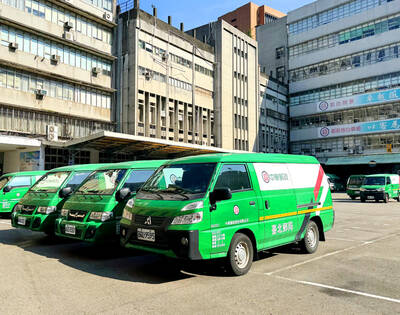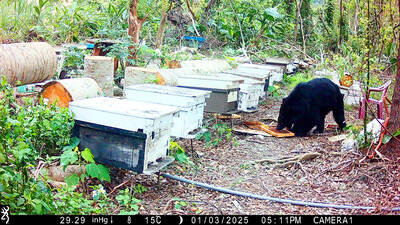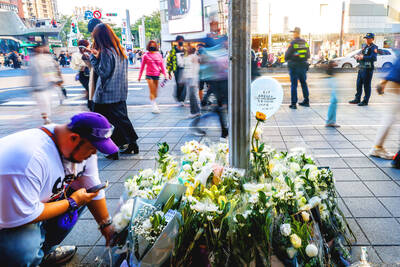Just 100 years ago, more than half the women in Taiwan had their feet bound and were kept at home, while some were sold as commodities, historical facts that are hard to comprehend today.
A reminder of those hardships can now be seen in Taipei at an Academia Sinica exhibition which offers a unique look into the lives of Taiwanese women and the evolution of their roles in society up to 1950 — from a female perspective.
Titled “Her History in Taiwan,” the exhibition shows how women lived, struggled and transformed their lives through a collection of marriage certificates, contracts, photographs, diaries and personal items selected from the digital archives of Academia Sinica’s -Institute of Taiwan History.
“Women’s history, or what women thought and wanted, is very often told by men,” institute director Hsu Hsueh-chi (許雪姬) said. “In the exhibition, we want women to speak for themselves and tell their story from their own perspective.”
Hsu, a Taiwanese history expert, said the exhibition focuses on items (dating as far back as 1795) collected from the Qing Dynasty to the Japanese colonial era (1895-1945) because it was during this period that women underwent the most substantial changes, both physically and mentally.
Though Taiwanese women in the late Qing Dynasty lived lives that were not as strict or traditional as those of women in China, they were still expected to “obey their fathers before marriage, their husbands during married life and their sons in widowhood,” Hsu said.
The documents show how unmarried women were often sold or traded as commodities to become adopted daughters, child brides, servants or even prostitutes.
During that era, women were also denied education unless they came from well-off families, Hsu said. Making matters worse was that many Taiwanese women found it difficult to walk because they had bound feet and were generally confined to their homes.
The practice of foot binding, which originated in China and was practiced for at least 1,000 years, was prevalent in Taiwan in the late Qing Dynasty and early years of Japanese colonial rule.
According to the Institute of Taiwan History, about 57 percent of women in Taiwan in 1905 had bound feet, but Hakka and Aborigine women did not observe the practice, differences among ethnic groups that are clearly seen in the exhibition’s photos.
Hsu said the first major change for women came in 1915, when the Japanese government officially announced a ban on foot binding.
“The Japanese colonial period marked the biggest transition of the fate of women in Taiwan. Not only were they liberated from foot binding, they began to receive public school educations and gradually became independent enough to show their talents in diverse fields,” Hsu said.
“We would like to invite more young students to come visit the exhibition,” the historian said. “Women have come a long way, but we are not there yet and we hope men will respect women more.”
“Her History in Taiwan” runs until Oct. 31 at the Institute of Taiwan History and admission is free.

SHIPS, TRAINS AND AUTOMOBILES: The ministry has announced changes to varied transportation industries taking effect soon, with a number of effects for passengers Beginning next month, the post office is canceling signature upon delivery and written inquiry services for international registered small packets in accordance with the new policy of the Universal Postal Union, the Ministry of Transportation and Communications said yesterday. The new policy does not apply to packets that are to be delivered to China, the ministry said. Senders of international registered small packets would receive a NT$10 rebate on postage if the packets are sent from Jan. 1 to March 31, it added. The ministry said that three other policies are also scheduled to take effect next month. International cruise ship operators

NUMBERS IMBALANCE: More than 4 million Taiwanese have visited China this year, while only about half a million Chinese have visited here Beijing has yet to respond to Taiwan’s requests for negotiation over matters related to the recovery of cross-strait tourism, the Tourism Administration said yesterday. Taiwan’s tourism authority issued the statement after Chinese-language daily the China Times reported yesterday that the government’s policy of banning group tours to China does not stop Taiwanese from visiting the country. As of October, more than 4.2 million had traveled to China this year, exceeding last year. Beijing estimated the number of Taiwanese tourists in China could reach 4.5 million this year. By contrast, only 500,000 Chinese tourists are expected in Taiwan, the report said. The report

The Forestry and Nature Conservation Agency yesterday launched a gift box to market honey “certified by a Formosan black bear” in appreciation of a beekeeper’s amicable interaction with a honey-thieving bear. Beekeeper Chih Ming-chen (池明鎮) in January inspected his bee farm in Hualien County’s Jhuosi Township (卓溪) and found that more than 20 beehives had been destroyed and many hives were eaten, with bear droppings and paw prints near the destroyed hives, the agency said. Chih returned to the farm to move the remaining beehives away that evening when he encountered a Formosan black bear only 20m away, the agency said. The bear

HORROR STORIES: One victim recounted not realizing they had been stabbed and seeing people bleeding, while another recalled breaking down in tears after fleeing A man on Friday died after he tried to fight the knife-wielding suspect who went on a stabbing spree near two of Taipei’s busiest metro stations, Taipei Mayor Chiang Wan-an (蔣萬安) said. The 57-year-old man, identified by his family name, Yu (余), encountered the suspect at Exit M7 of Taipei Main Station and immediately tried to stop him, but was fatally wounded and later died, Chiang said, calling the incident “heartbreaking.” Yu’s family would receive at least NT$5 million (US$158,584) in compensation through the Taipei Rapid Transit Corp’s (TRTC) insurance coverage, he said after convening an emergency security response meeting yesterday morning. National